For discerning car buyers in India, the Ford brand has always been a bit special. Ford cars not only tick the right boxes in tackling everyday concerns like safety, reliability, fuel-efficiency and passenger comfort, they also go above and beyond in terms of the sheer driving pleasure they deliver. Take the Ford EcoSport, for example, which is one of the best-selling vehicles in the compact SUV segment. With its compact dimensions, powerful and efficient 1.5-litre petrol and diesel engine options and outstanding performance, the EcoSport has been a big hit with car buyers in India.
While the EcoSport’s technical prowess and its accomplished driving experience are already widely acknowledged, did you know that it also offers some of the lowest maintenance costs in its segment? Yes, the EcoSport – as well as other cars and compact SUVs in Ford’s India lineup – offer the lowest running costs in their respective segments, as evinced by Autocar India’s latest Maintenance Cost Study.
Many first-time buyers only look at the initial price tag and fail to take into account factors like spare parts prices, longevity of consumables, labour rates and service costs, and service intervals. Autocar India’s Maintenance Cost Study helps buyers take these factors into account before making a purchase decision. In this study, cars and SUVs across multiple brands and segments were analysed and rated for their total maintenance costs, taking into account all the variables that can potentially push up the long-term cost of ownership. And, not surprisingly, Ford cars came out on top in most of their respective segments.
Lowest Running Costs Across Segments
The Ford Figo, one of the most engaging, enjoyable drives in the mid-range hatchback segment, also boasts the lowest running costs. Available with, both, 1.2-litre petrol and 1.5-litre diesel engine options, the Figo inches ahead of its rivals in terms of parts and service costs. The Maintenance Cost Study took into account the first six services, including parts and labour costs. With maintenance costs of Rs 0.34 per km for the petrol variant and Rs 0.45 per km for the diesel, the Figo came out on top, making it the leading contender in the mid-range hatchback segment.
Moving up to the compact sedan segment, the Ford Aspire performed very well, with the petrol variant posting a lowest-in-class maintenance cost figure. Taking into account parts and labour costs for the first six services, the Ford Aspire 1.2-litre petrol had a per km maintenance cost of Rs 0.34, which none of its rivals can match. The Aspire 1.5-litre diesel had a per km maintenance cost of Rs 0.45, which was bettered by the narrowest of margins by just one of its rivals, which makes both the petrol and diesel variants strong contenders in the compact sedan segment.

Compact SUVs are rapidly gaining popularity in India, and in this fast-growing segment, the Ford Freestyle simply annihilates its rivals, with a per km running cost of Rs 0.34 for the 1.2-litre petrol variant, and Rs 0.45 for the 1.5-litre diesel. Ford’s other compact SUV, the EcoSport, also does very well, with Rs 0.36 per km for the petrol variant and Rs 0.46 per km for the diesel. With this, Ford’s compact SUV duo stays ahead of rivals by a fairly significant margin.
If that wasn’t enough already, Ford also continues its winning streak in the premium SUV (ladder-frame) segment, with maintenance costs of Rs 0.71 per km for the Endeavour 2.0-litre diesel, which is the lowest in the segment. The Endeavour already has a well-earned reputation for being an all-around tough, do-it-all SUV. That it also boasts the lowest running costs in its segment just makes the deal sweeter.
Excerpts from Autocar India’s Maintenance Cost Study, which provide a detailed breakdown of how maintenance costs were calculated across segments, are presented in the following pages. The figures provided in those excerpts show how, and in what ways, Ford cars and SUVs earn an advantage over their rivals in terms of having the lowest maintenance costs. Read on to find out more.
Mid-Range Hatchbacks
With the budget and entry-level hatchbacks offering petrol-only power, the mid-range hatchback segment is where you will find the most affordable diesel. And while, in the pre-BS6 era, all the cars here had diesel power, it’s now only the Nios and Figo that come with diesel engines. The KUV100, Swift and the Ignis are now petrol only.
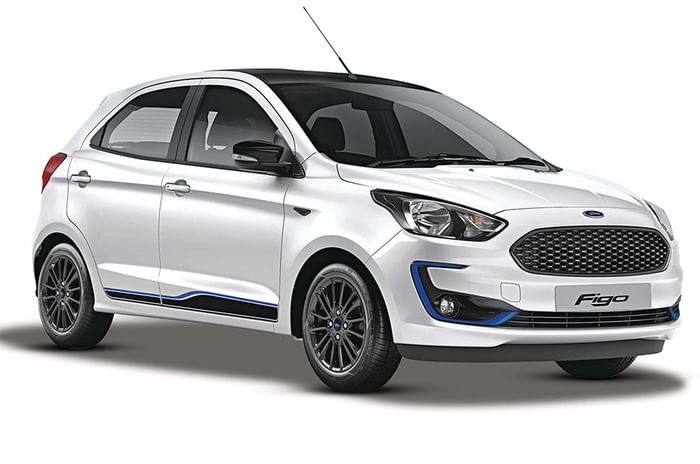
- One-year/10,000km is the standard service interval in this segment.
- It’s a close fight for the top spot between the Hyundai and the Ford, though the Figo comes out on top in both, petrol and diesel guises, narrowly pipping the Hyundai.
- Ford charges a flat rate of Rs 1,926 for labour from the 20,000km service, amounting to a total of Rs 9,630. Hyundai, on the other hand, charges for labour from the 30,000km service at a flat rate of Rs 2,620, amounting to a total of Rs 10,480.
- The Mahindra KUV100 has a higher number of replacement parts, but what balances the Mahindra’s cost are its labour rates. These are applicable from the 30,000km service onwards, averaging Rs 1,895 per service, which helps it tuck below the Maruti Swift and Ignis, the priciest cars to service in this segment.
- The two Marutis share the same engine and other components, but it is due to their preset labour charges that there is a slight difference in their total costs.

Compact Sedans
The sub-four-metre sedan or compact sedan is a segment unique to India. Born out of the regulation that gives vehicles shorter than four metres – and with engines less than 1.2 litres (petrol) and 1.5 litres (diesel) – certain tax breaks, the compact sedan was designed to provide the aspirational value of a sedan at an incremental price over a hatchback. And although this segment has witnessed an onslaught by compact SUVs, it still remains a busy space, with six offerings, namely the Tata Tigor, Honda Amaze, Ford Aspire, Hyundai Xcent, Hyundai Aura and the segment leader, the Maruti Dzire. After the onset of the stricter BS6 emission norms, Ford, Honda and Hyundai still offer petrol and diesel engine options, whereas Maruti and Tata are petrol only.

- A one-year/10,000km service interval is the norm in this segment, apart from the Tata Tigor, which has a longer, 15,000km service interval. Interestingly though, Tata calls in owners for a routine check-up every 7,500km, which is chargeable from the 22,500km mark, at Rs 850 per visit.
- What’s interesting is that, among the petrol sedans, the Honda Amaze, Ford Aspire and Hyundai Aura (with either the 1.0-litre or the 1.2-litre engine) are the most affordable to maintain, with identical costs of Rs 0.34/km.
- The Ford Aspire and Hyundai Aura also lock horns in the diesel segment and are the two most affordable ones, with near-identical costs of Rs 0.45/km and Rs 0.44/km, respectively.
- Ford’s labour rate is set at a flat Rs 1,926 from the 20,000km service onwards, which is the lowest in this segment.
- Surprisingly, the Xcent, which shares its 1.2-litre petrol and diesel engines with the Aura, is a bit pricier to maintain. Hyundai also charges higher labour rates for the Xcent, at Rs 2,873 per service, while the newer Aura’s labour charges are Rs 2,620 per service, both from the 30,000km service mark. Curiously, the Xcent’s pollen filter costs much more than the Aura’s.
- The Tata Tigor requires the fewest services due to the longer service interval, but it is the second most costly to maintain.
- The Maruti Dzire is the costliest petrol compact sedan to maintain, and while the cost of replacement parts isn’t particularly expensive, it is the labour charges from the 20,000km service, which average at Rs 2,700, that adds to the costs.
- The Honda Amaze diesel is much heavier on the pocket compared to the Ford Aspire, Hyundai Aura and Xcent. It is the only diesel car that requires a coolant change at the end of 60 months, which adds to its costs. And although not by a big margin, the Honda’s labour costs are also a bit higher than the rest.
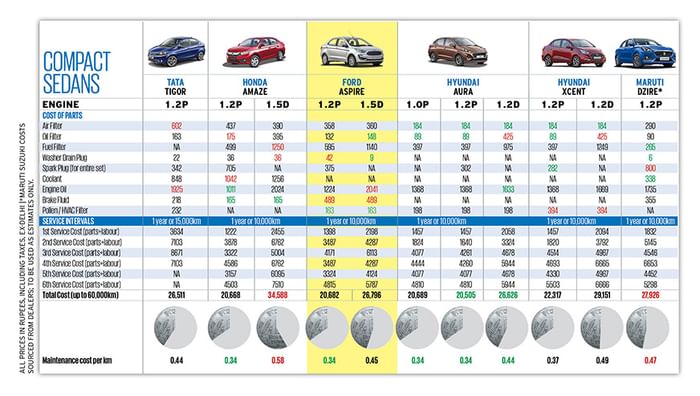
Compact Suvs
Compact SUVs seem to be just the perfect body style for India, combining the space and practicality of an SUV with the compact footprint of a small car. So much so that there have been three new launches in the segment in 2020 – the Sonet, Urban Cruiser and Magnite – which, though, are too new to include in this survey. This segment sees a fair fight between a number of players like the Maruti Brezza, Tata Nexon, Ford EcoSport and the Hyundai Venue. We’ve even included Ford and Honda’s compact crossovers, the Freestyle and WR-V.
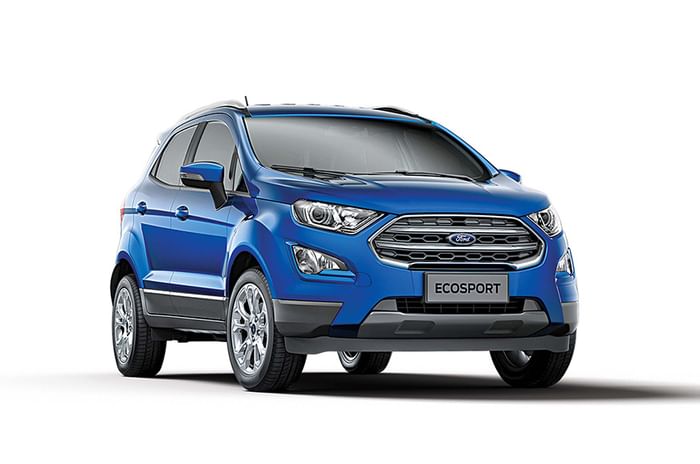
- All the compact SUVs have their service intervals set at one year/10,000km, except the Tata Nexon whose intervals are one year/15,000km.
- The Ford Freestyle, whether with the 1.2-litre petrol or the 1.5-litre diesel, turns out to be the most economical to run.
- In the case of the Hyundai Venue, labour is chargeable from the 30,000km service onwards, at a flat Rs 2,220, making it among the more affordable ones to run.
- The Honda WR-V is one of the pricier cars to maintain in the segment, with the petrol version’s maintenance cost per kilometre being even higher than most of its diesel competitors.
- The running costs of the Tata Nexon are higher than the Honda, due to costlier replacement parts. The Tata also requires a minor check-up service at intervals of 7,500km, which is chargeable at Rs 1,000 for each service, starting with the 22,500km check-up (which we have included in the second, third and fourth service costs).
- Surprisingly, the Maruti Vitara Brezza is the priciest to maintain here. And while its service costs are lower than those of the petrol Nexon, it requires two more services before the 60,000km mark.
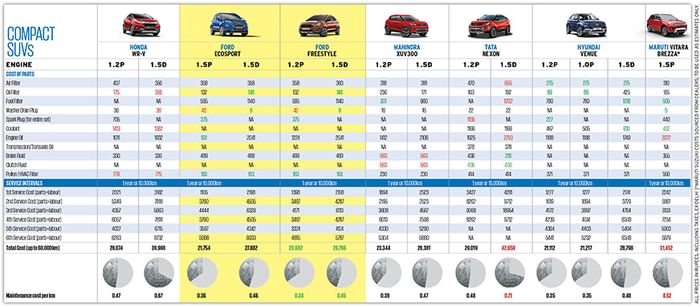
Premium Suvs
This segment is sub-divided into two classes – monocoque SUVs like the Honda CR-V, Volkswagen Tiguan Allspace and Hyundai Tucson, and body-on-frame SUVs like the Mahindra Alturas G4, Toyota Fortuner and Ford Endeavour.
.jpg?w=700&c=0)
Monocoque Suvs
- The Hyundai Tucson offers petrol and diesel engines, as did the Honda CR-V before BS6, whereas the Volkswagen Tiguan Allspace is a petrol-only offering.
- Besides being an import, what makes the Tiguan Allspace the costliest are the prices of its transmission fluid, transfer case oil and spark plugs, all of which need replacement at 60,000km. Even the total labour charges will set you back by Rs 27,893 over the second, third and fourth paid services.
- The Honda CR-V is the only one that requires a coolant change that happens every five years.
- Hyundai charges for labour from the 40,000km service onward and the Tucson proves to be the most pocket friendly, with the fewest parts requiring replacement, and with affordable rates.
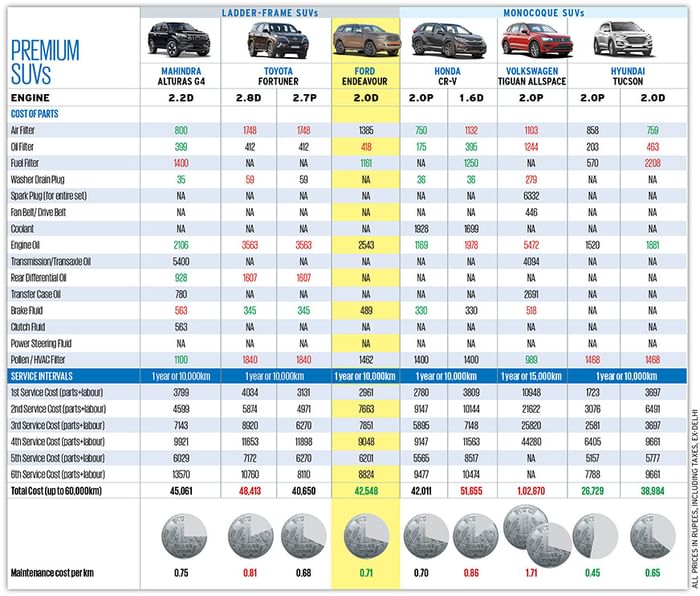
Ladder-Frame Suvs
- The Ford Endeavour is the most economical to run, with the lowest cost of replacement parts, and a flat labour rate of Rs 3,240 for the paid periodical services.
- Mahindra boasts of the cheapest replacement parts and labour rates, but it requires additional replacement parts such as a fuel filter, transmission/transaxle oil, rear differential oil, transfer case oil and clutch fluid, thus it comes in a bit higher than the Ford.
- The Fortuner diesel is a bit more expensive to run than the Endeavour as, among other things, Toyota replaces the rear differential oil every 40,000km.





























